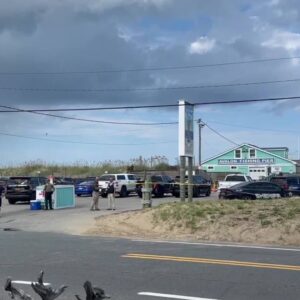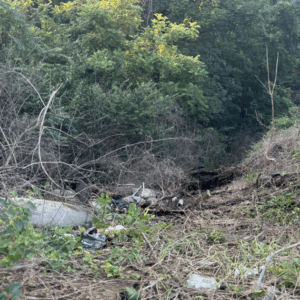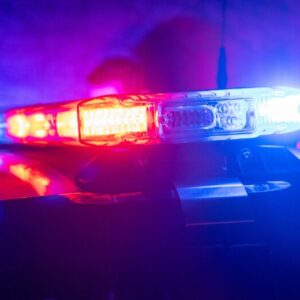In a small, rented lab in the port of Los Angeles in May, Keith Matassa was working through a backlog of bodies on ice. Using a surgical knife, he carefully removed a California sea lion fetus from a uterus. The month before, Matassa tended to its mother — the fifth carcass he’d worked on at the end of a long day. He hadn’t had the energy to examine her baby, too.
It had been nearly three months of long days for Matassa. As the founder of the Ocean Animal Response and Research Alliance (OARRA), he studies the dead mammals that wash up along LA’s 70 miles of coastline. Between February and May, NOAA Fisheries estimated that stranding coordinators — the people who provide medical help to live, stranded animals, or perform necropsies on dead ones — responded to some 1,700 imperiled sea lions and dolphins on Southern California beaches. At least 75% of the animals were already dead, or later died. By just three weeks in, OARRA’s two-person team and a crew of volunteers had tackled as many incidents as they would normally see in a year.
During this wave of mortality, Matassa’s workday started at 6 a.m. on the beach— “our lab,” as he calls it — and went on until 7 p.m. or so. He’d talk and text with lifeguards about the animals they found and ferry body parts to the freezers, either at the port or in their homes, where he and his field biologist store samples. Mostly, he performed necropsies — dissecting dead animals, like this sea lion fetus.
Matassa was careful and reverent as he cut. He pointed out the fetus’ vibrant red ribcage, the noodly tube of its trachea, and the bean-sized but “powerful” adrenal gland: all of them “perfect structures,” he observed. When Matassa created OARRA five years ago, it was nobody’s job to study the many dead marine mammals that wash up on LA’s beaches. Matassa, who’d previously worked in animal rehab, hoped that by keeping his eyes on the water, he could help prepare the area’s veterinarians for waves of creatures in urgent need of treatment. But he was especially curious about the animals that would never make it to the hospital in the first place.

OARRA collects samples of dead animals’ lungs, brains, blubber and more, compiling a biological library of clues for researchers around the country. The data helps scientists learn more about what’s going on in the bodies of marine mammals, in the ocean and on our planet as a whole.
The blotches of bruising on this fetus’ skull were the only visible sign of what went wrong. Matassa suspected a common culprit — Pseudo-nitzschia australis, an algae that produces a neurotoxin called domoic acid. During algal blooms, domoic acid can accumulate in shellfish, sardines and anchovies, shutting down some fisheries and spelling tragedy for the sea lions and dolphins that eat those fish. Mammals that consume too much of the toxin suffer seizures, heart attacks and brain damage. This year’s neurotoxin outbreak was particularly devastating, and started several months earlier than Matassa had come to expect.
Matassa filled a couple dozen vials with the sea lion’s innards. Cross-referencing the fetus’ samples with those collected from its mother’s body will help illuminate how and why the neurotoxin is so deadly — especially for pregnant sea lions.
“Every dead animal has a story to tell,” Matassa said, “and we need to tell it.”
DOMOIC ACID TOXICOSIS isn’t a new phenomenon. Scientists at The Marine Mammal Center in Sausalito, California, first documented the condition in 1998, but over the past four years, outbreaks have become increasingly common in California. “We have been grappling as a community with this sense that, like wildfires, these things are kind of year-round now,” said Clarissa Anderson, an oceanographer at University of California San Diego’s Scripps Institute and director of the Southern California Coastal Ocean Observing System. Anderson’s research shows that the upwelling of nutrients from deeper, colder waters seems to drive the recent algal blooms. She developed the CA-Harmful Algae Risk Mapping system to track and predict them.
“A lot of the problems that animals have as individuals are related to human activities.”
The data that Matassa and his team collect is crucial to helping researchers understand the big picture. This spring, Anderson and her colleagues held weekly calls with stranding teams like OARRA to compare notes and plan for data collection — lines of communication she believes will be critical in years to come. The data that the stranding coordinators record reveals where the toxin shows up in a carcass and how the animal died, and their observations on the beaches — both at baseline and during an outbreak — can help answer her many remaining questions: Why do some years see an outbreak of domoic acid toxicosis in mammals while others don’t, even when the algae is present in the water column? How does runoff from the land impact phytoplankton and marine mammals? And how are rising global greenhouse gas emissions altering the water’s chemistry?
“A lot of the problems that animals have as individuals are related to human activities,” said Cara Field, the director of conservation medicine at The Marine Mammal Center.
Caring for and healing live animals makes for more inspirational stories than working with “dead things,” as Matassa puts it. But by studying these dead things, he’s banking knowledge that may prove to be of great value years from now. A diligent necropsy can take several hours to complete, even with several people helping. Everyone clusters around the animal — often in the bed of Matassa’s truck — to make cuts, collect samples, take pictures and record notes. It’s an act of faith in what science can learn about these animals’ health — and perhaps our health as well.
Back at the lab, Matassa labeled and filed each sample, in a process that’s ingrained in his muscle memory. Like the urine, fecal and stomach content samples he collected and shipped from 122 other marine animals so far this year, these will be sent to pathologists and to the Northwest Fisheries Science Center in Seattle. He looked over the remains of his morning’s work with weary, frank optimism. “There’s nothing hidden inside that animal anymore,” he said.





